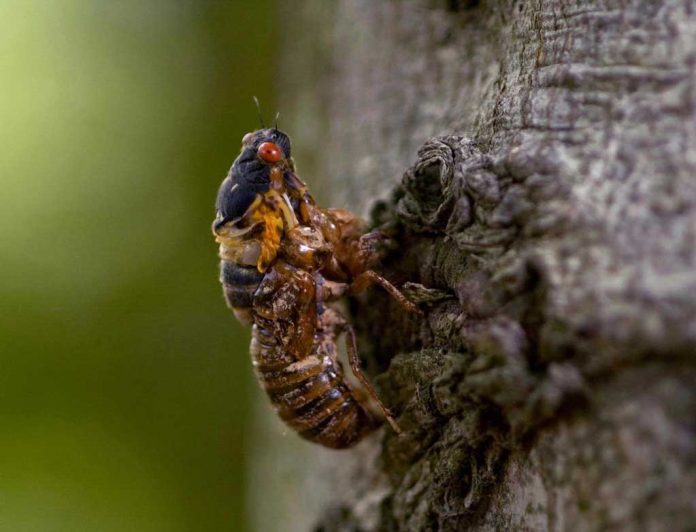
Periodical cicada Brood VIII (eight) will emerge, in mid-May or June, in western Pennsylvania, eastern Ohio and the northern panhandle of West Virginia. The last time this brood emerged was in 2002.
Periodical cicadas can emerge by the millions within a matter of hours after having spent 13 or 17 years underground. It is the longest-lived insect in North America.
There are six species of periodical cicadas, three with a 17-year cycle and three with a 13-year cycle. The three species in each life-cycle group are distinctive in size, color and song.
The 17-year cicadas are generally northern, and the 13-year cicadas southern with considerable overlap in their distribution.
For the convenience of reference, each “brood” has been designated by a Roman numeral. The numbering of the 17-year broods began with the 1893 brood which was designated as Brood I.
Adults are about 1 and 1/2 inches long and have eyes and wing veins that are reddish orange. They are smaller than their cousins, the dog-day cicadas.
Life history
After 17 years of living in the soil from depths of 2 to 24 inches, mature nymphs of the periodical cicada start burrowing upward. In April, they burrow to about an inch beneath the soil surface where they stop and await the proper time to emerge (when the ground is about 64 degrees).
If the ground is too damp, mature nymphs build a protective earthen turret. Their bodies undergo major changes in muscle structure at this time.
When the undetermined signal for emergence occurs, nymphs exit from about a 1/2 inch diameter hole in the ground.
Nymphs crawl a foot or more up tree trunks, weeds, or other upright objects where adults emerge leaving their nymphal skins behind.
The process of shedding a nymphal skin is completed in an hour or less. The periodical cicada is now an adult, but it is soft and white. In time, its exoskeleton hardens and becomes darker.
During some years, practically all of the population in a brood from a forest may emerge on the same night, or on two or three different nights. Adults are rather clumsy fliers and often collide into objects during flight.
Soon after emerging, males begin their constant “singing” while females remain silent. The sound made by adult males is sometimes haunting and eerie.
About 10 days after emergence, females will mate and begin depositing eggs in twigs and branches of nearly 80 different preferred species of trees and woody shrubs.
They usually do not deposit eggs in coniferous trees. Generally, the female will deposit 400-600 eggs in the twigs of their preferred species.
Using the blades of a saw-like, egg-laying device at the end of the abdomen, females puncture the bark of a twig and make a pocket in the wood. Females may deposit from 24-28 eggs in two rows in one of these pockets.
They then move forward, cut another pocket, and lay more eggs.
Adults live for approximately three to four weeks above ground. Most are usually gone by the beginning of July.
Hatching occurs six to seven weeks after egg laying, and the white, ant-like nymphs work their way out of the slits and drop to the ground where they enter the soil. Here they insert their piercing-sucking mouthparts and draw plant fluid from roots of plants for the next 17 years.
The number of nymphal instars (growth phases) is still uncertain, although some studies indicate that there are five instars.
Damage
Adults do not feed on leaves. If they feed at all, it is by sucking plant fluid from tender young twigs.
The most noticeable damage done by periodical cicadas is from egg-laying. Twigs slit by the female’s ovipositor will frequently have leaves that wilt and die.
Fruit and nut orchards can suffer heavy pruning losses from high populations of these insects.
Management
A periodical cicada year is a time of feasting for a surprising array of creatures. Birds and fish feed ravenously on the adult stage of these insects. Grackles and crows voraciously dine on periodical cicadas.
Fish will literally gorge themselves on adult cicadas when they are abundant in trees and shrubs along a stream.
Small trees can be covered with a mesh cloth to prevent the females from laying eggs in the twigs. Delaying the planting of trees during a cicada year may also be considered.










